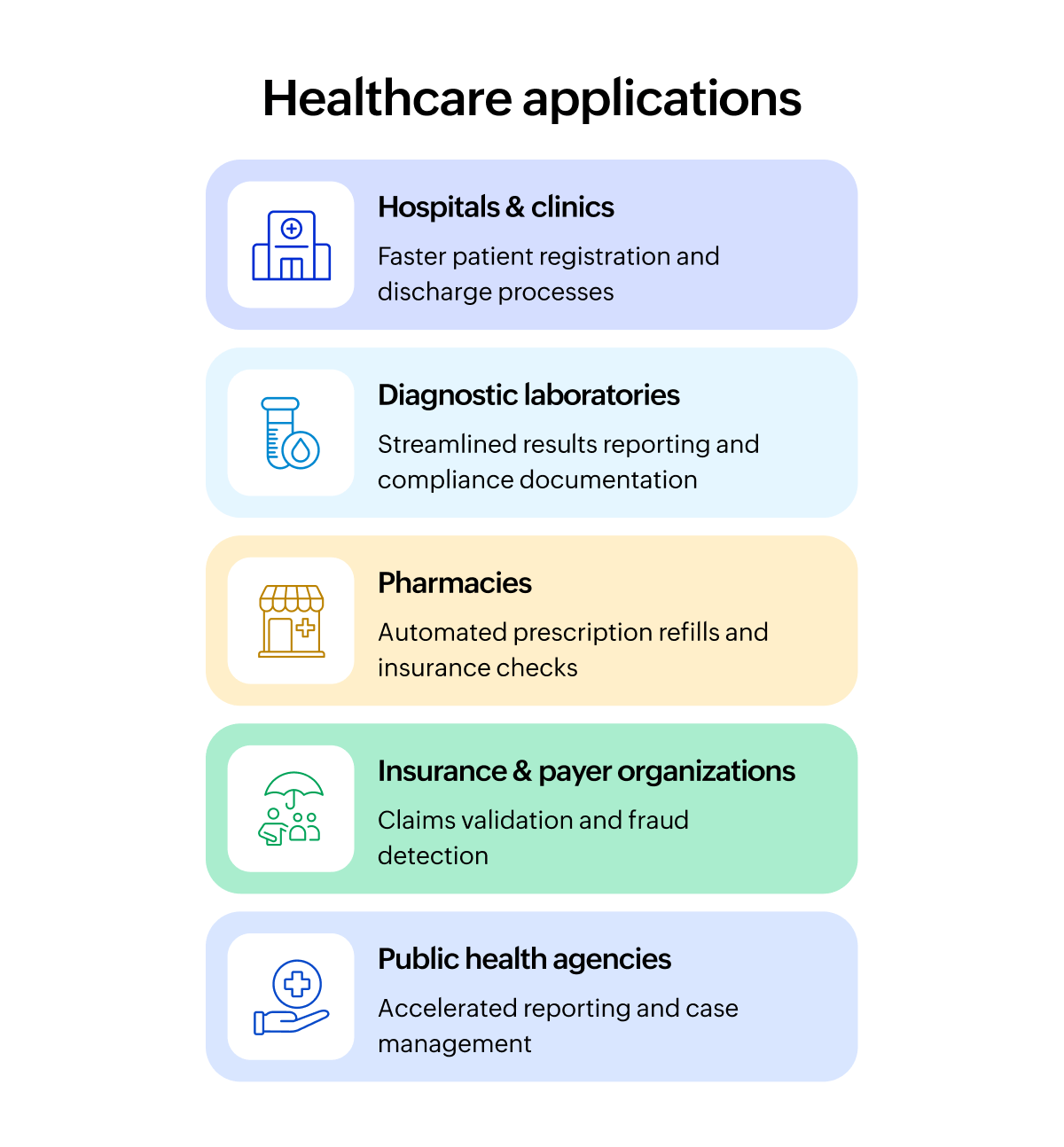Cutting healthcare admin overload with robotic process automation

- Introduction
- Automation needs in healthcare
- What RPA brings to the table—and when to use it
- Where the interest is emerging
- Where RPA is already making an impact
- Transform healthcare operations today
- Exploring how automation could work in your healthcare operations?
Introduction
Walk into any hospital—on one side, you'll see patients waiting for care, and on the other, staff navigating a maze of systems, forms, and processes that all demand their attention.
But it's not just about scheduling and billing. It's lab results that need to be updated across platforms, appointment slots that go unused, compliance logs that have to be ready for audits, inventory tracked down before it expires, and sensitive data that must be handled without error.
These bottlenecks aren’t mere inconveniences. Studies show that healthcare managers spend over 20 hours a week on administrative tasks and bureaucracy like scheduling and documentation. Over a third of this time is lost due to outdated technology and manual processes, draining resources, increasing costs, and in some cases affecting the quality of patient care.
Automation needs in healthcare
Healthcare is an environment where urgency and accuracy are non-negotiable, and the workload never seems to shrink. As patient volumes grow and care models evolve, many organizations are realizing they face three key operational pressures:
Fragmented systems
Hospitals, clinics, labs, and pharmacies often use a mix of modern cloud platforms and older legacy software. This can make it challenging to share information efficiently.
Repetitive manual tasks
Data entry, form filling, and updating multiple records with the same information not only consumes time but also increases the risk of human error.
Time-consuming screen navigation
Staff often re-enter details, click through menus, copy data between fields, or upload reports across several systems. These steps do not require medical expertise, but they do take time away from patient care.
Traditional automation tools, custom connectors, or new system roll-outs can help, but they usually depend on full system integration. In healthcare, there are often dozens of separate, unconnected applications in daily use. This forces staff to rely on constant screen interactions to move information from one system to another.
That is where the conversation about robotic process automation (RPA) starts to make sense.
What RPA brings to the table—and when to use it
Robotic process automation in healthcare uses software bots to handle repetitive, rules-based tasks that follow the same steps every time. Instead of depending on complex system integrations, RPA interacts with applications the way a human would. It opens screens, enters data, clicks through menus, reads fields, and moves information from one place to another.
It’s especially useful when work involves:
- Moving data between systems like legacy desktop applications that aren’t connected, as they don't have any APIs
- Following multi-step, rules-based processes across different applications
- Completing time-sensitive tasks that don’t require human judgment
- Handling high volumes of UI interactions, like navigating forms or copying data between fields
If your process uses the same clicks, keystrokes, and screens on repeat, it’s a strong candidate for RPA.
Where the interest is emerging
The RPA conversation in healthcare isn't confined to one department:

- Automating data entry and patient record handling in hospitals and clinics.
- Reducing turnaround times for test results and regulatory reports in diagnostic labs.
- Supporting chemist's shop workflows for refills, billing, and insurance validation.
- Improving claims accuracy and fraud detection for insurers and payers.
- Accelerating reporting and compliance in public health organizations.
These examples come from real operational challenges where RPA is already delivering results. You can go through this page to see more healthcare scenarios that benefit from automation.
Where RPA is already making an impact
Across healthcare, the early wins are emerging in concrete areas, not flashy projects—everyday processes that add to significant time and cost savings.
Frictionless resource booking for surgeries
Coordinating an operation requires aligning surgeons, operating rooms, specialized equipment, and available staff, all simultaneously. RPA bots can check availability across hospital systems, secure the needed resources, and send confirmations to everyone involved. What once took hours of phone calls can now happen in minutes.
Streamlined patient consent management
Patient consent forms are essential for compliance but can be easy to misplace or let expire. RPA quietly extracts consent data from digital forms, stores it securely in EHR systems, and monitors expiration dates. Patients and staff also receive reminders before renewals are due, avoiding last-minute delays in treatment.
Compliance without the crunch time
When regulators call, every report must be accurate, formatted correctly, and submitted on time. Instead of staff pulling late nights to compile data, RPA gathers information from clinical, billing, and CRM systems at scheduled intervals, generates compliant reports, and even submits them through the right portals. The process becomes routine, rather than a fire drill.
Faster, cleaner claims processing
Insurance claims can stall over missing details or slow follow-ups. RPA ensures patient coverage data is correct from the start, submits claims through payer and insurance claims processing systems, and tracks their progress. Patients are updated on approvals or rejections promptly, and finance teams can focus on exceptions rather than routine cases.
Transform healthcare operations today
The goal of automation in healthcare isn’t to replace people. It is to give them more time for the work that truly requires human expertise, like diagnosing patients, providing care, and making critical decisions.
With staffing shortages, rising patient demand, and tight budgets converging, operational efficiency is becoming just as critical as medical innovation. RPA is a practical, flexible tool that can help bridge today’s resource gaps while laying the groundwork for smarter systems tomorrow.
For healthcare leaders, the decision isn’t just whether to adopt RPA. It’s about identifying where automation can have the greatest impact now and building a foundation that will support a more connected, responsive, and patient-centered future.